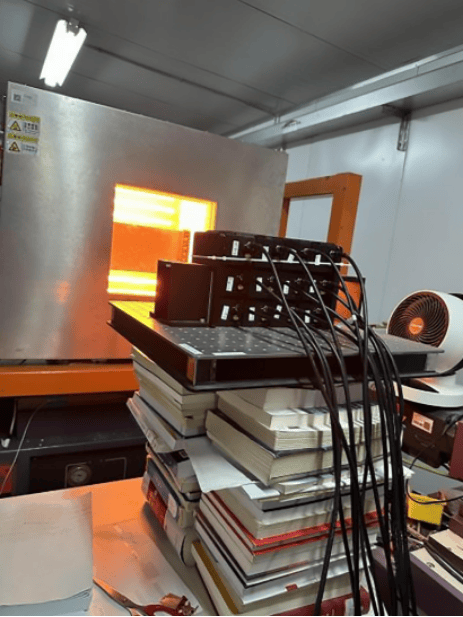Multi-Channel Laser Vibrometer for Modal Testing
1. Executive Summary
A leading aerospace research institute faced the challenge of characterizing the dynamic properties of an advanced material intended for high-temperature applications, such as engine components or thermal protection systems. Traditional contact-based measurement methods (e.g., accelerometers) were unsuitable due to their mass-loading effects and inability to withstand extreme temperatures. The institute employed the Dynatronic VibroMicro VM-S-100 Multi-Channel Laser Doppler Vibrometer to perform non-contact, synchronous modal testing. The solution successfully provided precise data on the material's natural frequencies, damping ratios, and mode shapes across a range of elevated temperatures, enabling critical insights for design validation and thermal-structural analysis.
2. Challenge: Modal Analysis Under High-Temperature Conditions
The dynamic behavior of materials—specifically their natural frequency, damping, and structural deformation patterns (mode shapes)—is highly sensitive to temperature changes. For aerospace components operating in extreme environments, understanding this temperature-dependent behavior is crucial for predicting vibration, avoiding resonance, and ensuring structural integrity and longevity. The key challenge was to accurately measure these modal parameters without the physical and thermal limitations of contact sensors.
3. Solution: Non-Contact Multi-Point Vibration Measurement
The Dynatronic VibroMicro VM-S-100 system was selected as the ideal solution for this application due to its core capabilities:
Non-Contact Measurement: Laser-based measurement eliminated mass-loading and stiffness-altering effects, ensuring data reflected the true dynamic characteristics of the test specimen.
Multi-Channel Synchronization: The system allowed for simultaneous vibration measurement from multiple points, drastically reducing test time and guaranteeing phase coherence for accurate modal shape identification.
High-Fidelity Data: Laser Doppler technology provided nanometer-level displacement resolution, capturing even minute vibrations with high precision.
Robustness for Harsh Environments: The optical probes could be positioned remotely from the high-temperature zone, protecting the equipment while allowing measurement of the heated specimen.
4. Test Setup and Procedure
Equipment:
Dynatronic VibroMicro VM-S-100 Multi-Channel Laser Doppler Vibrometer
High-Temperature Environmental Chamber (e.g., furnace)
Excitation System (Shaker with high-temperature stinger or non-contact actuator)
Data Acquisition and Modal Analysis Software
Methodology:
Specimen Preparation: The high-temperature material specimen was prepared and placed inside the environmental chamber.
Measurement Points: A grid of 12 measurement points was defined on the specimen's surface to adequately capture the expected mode shapes.
Temperature Control: Tests were conducted at a series of stabilized temperature setpoints (e.g., Room Temperature, 200°C, 400°C, 600°C).
Excitation and Data Acquisition: At each temperature, the specimen was subjected to a swept-sine excitation. The VM-S-100 system simultaneously captured the vibration velocity/displacement responses from all 12 points.
5. Data Analysis
Frequency Response Function (FRF) Estimation: The acquired time-domain data from each point was processed to calculate the FRF (output response/input force).
Modal Parameter Extraction:
Natural Frequencies: Identified from the peak locations in the FRF magnitude plots.
Damping Ratios: Calculated using the Half-Power Bandwidth method or advanced curve-fitting techniques on the FRF data around each resonance.
Mode Shapes: A global modal parameter estimation algorithm (e.g., VibroSoft) was used to synthesize the FRF data from all 12 points, animating the operational deflection shapes to visualize each mode.
6. Results and Conclusion
The testing campaign yielded a comprehensive dataset of the material's modal parameters as a function of temperature. Key results included:
Quantification of the downward shift in natural frequencies with increasing temperature.
Characterization of the increase in material damping ratio at elevated temperatures.
Clear visualization of mode shapes, identifying nodes and antinodes critical for design.
Conclusion:
The Dynatronic VibroMicro VM-S-100 Multi-Channel Laser Doppler Vibrometer proved to be an indispensable tool for advanced materials research under extreme conditions. Its non-contact, synchronous multi-point measurement capability successfully overcame the limitations of traditional sensors. The high-quality data provided the client with vital insights into the thermo-dynamic behavior of their material, directly supporting the development of safer, more reliable, and high-performance aerospace systems. This application underscores the value of laser vibrometry in pushing the boundaries of experimental structural dynamics.

